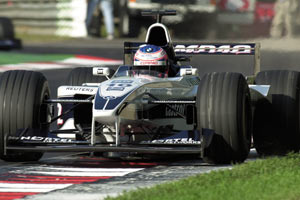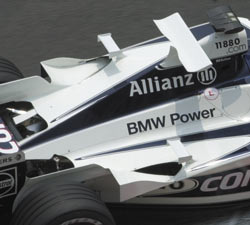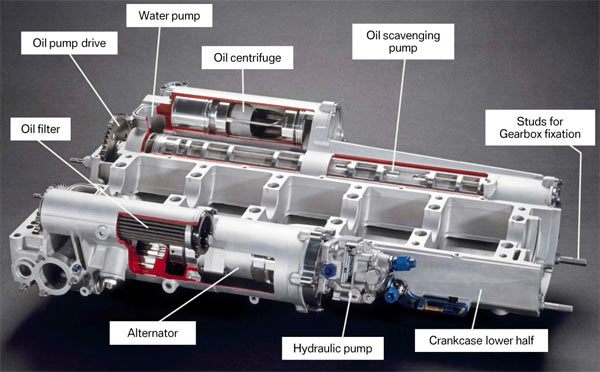BMW WilliamsF1 FW22

Active: 2000
Team: Williams F1
Designer: Patrick Head (TD), Gavin Fisher (CD), Geoff Willis (CA)
Drivers: Ralf Schumacher (9), Jenson Button (10)
The FW22 is the first Williams car to benefit from the alliance with BMW. It is also branded in different colours and displays several new sponsors. After losing official Renault engines at the end of 1997, the team struggled to stay on top with the Mecachrome and Supertec engines. Its new partnership with BMW meant the team had more resources to put into developing the car.
 However, 2000 was to be a learning year despite intensive engine testing by BMW in 1999. While it proved decent enough, the engine was longer and heavier than the Supertec of 1999. Hence, the car's wheelbase was extended by 7 cm while the sidepods were made higher to provide the BMW engine with enough cooling. The latter compromised aerodynamic gains which the team tried to compensate with additional winglets ahead of the rear wheels. In Hungary, they even used a "top wing" on the airbox.
However, 2000 was to be a learning year despite intensive engine testing by BMW in 1999. While it proved decent enough, the engine was longer and heavier than the Supertec of 1999. Hence, the car's wheelbase was extended by 7 cm while the sidepods were made higher to provide the BMW engine with enough cooling. The latter compromised aerodynamic gains which the team tried to compensate with additional winglets ahead of the rear wheels. In Hungary, they even used a "top wing" on the airbox.
The most important changes on the FW22 are a result of regulation changes and the new engine that needed a place. Over the winter, the FIA decided to increase the minimum height of the cockpit surroundings to better protect the driver's head, while the side impact crash test was toughened. Similar to all other teams, Williams extended the sidepods more to the front to incorporate the sideways crash structures. As engine cooling can be greatly improved by cleaning up airflow ahead of the sidepod inlets, the team also decided to remove the barge boards and opt for guiding vanes. These vanes have a similar functionality but are located in between the front suspension arms.
Additionally, the FW22 is the first Williams car to sport a 7-speed gearbox with an aluminium casing. 7 speeds are generally better when engine torque is too low at lower revs, a problem that many new engines in F1 suffer. The longer gearbox - compared to the six-speed version of the FW21 - completed the longer car and allowed for the diffused to be designed more efficiently.
The car was launched on 24 January at the Circuit de Catalunya in Barcelona, Spain. Earlier in the month, on 10 January the team was officially presented in Munich by Dr.-Ing. Wolfgang Ziebart, member of the board of BMW AG. The new alliance team was named "BMW Williams Formula One Team".
At the car's launch, team principal Frank Williams declared that Jenson Button (20) would team up with Ralf Schumacher as race driver. Bruno Junqueira (23) was appointed as the official test driver. "We wanted to give both drivers as much running as possible before we made the decision", commented Frank Williams. They could have had more running but, by the smallest of margins, we decided to go for Jenson because we feel that over the long term he has truly vast potential". A delighted Jenson Button said, "I think I'm still on Cloud Nine at the moment. It´s an amazing feeling being part of the BMW WilliamsF1 package."
Compaq Computer Corporation was announced the team's new principal sponsor. Compaq's support represented the first non-tobacco industry principal sponsorship of a championship pedigree team in the 50 year history of Formula One.
The FW22 was designed by a team led by Chief Aerodynamicist, Geoff Willis and Chief Designer, Gavin Fisher, who explained the principles behind its design: "The philosophy behind the FW22 has been one of intelligent design evolution rather than revolution. Although our final championship position last year was somewhat short of what we had hoped, there were specific performances, which showed that the basic principles of the car were based on solid foundations. There are no substantial regulation changes this year, but we are, of course, beginning a new era with BMW. A new engine brings new problems that require new solutions."
Geoff Willis takes up the story: "The external shape of the FW22 reflects the results of a continuous programme of design and wind tunnel testing. Aerodynamically last year?s car was very competitive in low and medium trim but suffered from problems at higher downforce circuits. We have made a good improvement with the overall aerodynamic performance so far and have focused on solving the characteristic problems of last year."
When the FW22 was unveiled, logos of www.11880.com, the website address of Telegate AG, a directory company, were also seen for the first time.
Performance wise, the FW22 was no match for Ferrari and McLaren who fought it out for the championships. At the end of the season, Ferrari totalled 170 points and McLaren 152. Williams was a distant third with 36 points. The best race finishes during the season were three podium finishes recorded by Ralf Schumacher.
Engine
Despite having a free choice in the number of cylinders, from 1998 all the manufacturers eventually ran V10 engines (Ferrari had initially come up with a V12 and Ford a V8). The BMW E41/4 race engine for the 2000 season was likewise a V10, an evolution of the concept engines already produced. It was developed within challenging constraints. There was intense time pressure, the team was still in the process of being put together, there were no established processes, quality standards were incomplete, and improvisation was a feature of parts logistics.As the new season dawned, the E41/4 was not yet race-ready and the failure rate was correspondingly high. Output was approximately 750 hp at a maximum 17,000 rpm. Things settled down in terms of both engineering and processes as the season progressed, and the engine eventually achieved 810 hp and 17,500 rpm. BMW had established itself with the E41/4.
As far as its design was concerned, the E41/4 was a V10 of conservative dimensions: a bore spacing of 107 mm and a 94 mm cylinder bore enabled generous cooling between cylinders and a 72° cylinder bank angle produced even firing intervals. The engine’s dimensions and weight were greater than those of the leading rivals. By the end of the season, the E41/4 was a competitive proposition in terms of performance and reliability.

A special feature of the engine design was the integration of the pumps and ancillary components into tubular mounts in the bottom half of the crankcase. This configuration was a substantial factor in achieving the extremely rigid (92 KNm/°) construction of the E41/4, but was extremely difficult to assemble and maintain. On the right-hand side were seven internal rotor-type oil scavenging pumps fitted with plastic rotors – one pump for each crankcase chamber, one for both cylinder heads and one for the gear drive. Alongside, the air was separated from the oil by a centrifuge. On the left-hand side behind the easily accessible oil filter was the oil pressure pump, and behind that were the alternator and hydraulic pump. The drive shaft speed between oil pump and alternator was increased using a small planetary gear set. On both the left and right-hand side of the engine, a water pump was integrated into the casing in front of these components.
Specifications
Chassis: Carbon Aramid epoxy composite, manufactured by WilliamsF1, carrying the engine as fully stressed member.Transmission: Seven speed gearbox, WilliamsF1 semi-automatic
Wheels: O.Z.; 13 x 12 front, 13 x 13.7 rear
Tyres: Bridgestone
Front suspension: Upper and lower carbon wishbones and pushrods. Torsion bar springing and anti roll bar.
Rear suspension: Upper and lower carbon links and pushrods. Coil springs and torsion anti-roll bar.
Brakes: Carbon discs and pads operated by AP calipers
Dimensions:
- Length: 4,540 mm
- Front track: 1,460 mm
- Rear track: 1,400 mm
- Wheelbase: 3,140 mm
- 600kg including driver and camera weight
Engine specifications
 Engine designation: BMW E41-4
Engine designation: BMW E41-4
Capacity: 2,998 cc
Architecture: 72° V10
Piston bore: 94 mm
Piston stroke: 42.3 mm
Cylinder spacing: 107 mm
Bank offset: 20.5 mm
Width: 524 mm
Height: 395 mm
Centre of gravity height: 167 mm
Weight: 117 kg
Length: 620 mm
Power output: 810 bhp @ 17500 rpm
Maximum torque: 350 Nm
No. of valves: 40
Intake valves: 40.5 mm, titanium
Exhaust valves: 31.2 mm, titanium
Fuel: Petrobras
Oil: Castrol
